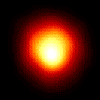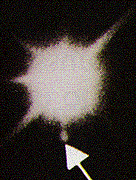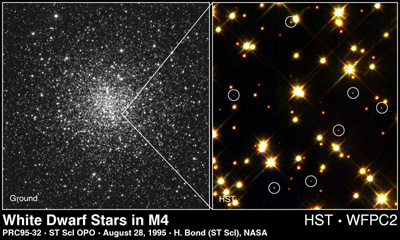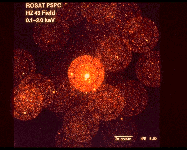White Dwarfs
Introduction to White Dwarfs
Where a star ends up at
the end of its life depends on the mass, or amount of matter,
it was born with. Stars that have a lot of mass may end their lives as
black holes or
neutron stars.
Low and medium mass stars will become something called a white dwarf.
A typical white dwarf is half as massive as the Sun, yet only slightly
bigger than the Earth. This makes white dwarfs one of the densest forms of
matter, surpassed only by
neutron stars.

|

|

|
| Black Hole |
Neutron Star |
White Dwarf |
Medium mass stars, like our Sun, live by burning the hydrogen that dwells
within their cores, turning it into helium. This is what our Sun is doing
now. The heat the Sun generates by its nuclear fusion of hydrogen into
helium creates an outward pressure. In another 5 billion years, the Sun will
have used up all the hydrogen in its core.
This situation in a star is similar to a pressure
cooker. Heating something in a sealed container causes a build up in
pressure. The same thing happens in the Sun. Although the Sun may not
strictly be a sealed container, gravity causes it to act like one, pulling
the star inward, while the pressure created by the hot gas in the core
pushes to get out. The balance between pressure
and gravity is very delicate.
When the Sun runs out of hydrogen to burn, gravity temporarily tips the
balance, and the star starts to collapse. But compacting a star causes
it to heat up again and it is able burn what little hydrogen remains
in a shell wrapped around its core.

January 15, 1996,
Hubble Space Telescope
Captures First Direct
Image
of a
Star, A. Dupree (CfA)
and NASA.
|
This burning shell of hydrogen will give our Sun the energy to expand again.
When this happens, our Sun will become a red giant; it will be so big that
Mercury will be completely swallowed!
When a star gets bigger, its heat spreads out making its overall
temperature cooler. But over time, the core temperature of our red giant Sun
will increase again until it's finally hot enough to burn all the stored up
helium it created in its former incarnation. Eventually, it will transform the
helium into carbon and other heavier elements. The Sun will only spend one
billion years as a red giant, as opposed to the nearly 10 billion it spent
busily burning hydrogen.
|
We already know that medium mass stars, like our Sun, become red
giants. But what happens after that? Well, our red giant Sun is still
eating up helium and cranking out carbon. But when it's finished its
helium, it isn't quite hot enough to be able to burn the carbon it created.
What now?
Our Sun isn't hot enough to ignite the carbon it its core, so the only
thing it can do is succumb to gravity again. When the core of the star
contracts, it causes a release of energy that makes the envelope of the
star expand. Now the star has become an even bigger giant than before!
Our Sun's radius has become larger than Earth's orbit!
The Sun is not very stable at this point and loses mass similar to how
a boiling kettle loses water by releasing steam. This continues until
the star finally blows its outer layers off in a gust of superwind.
The core of the star, however, remains intact, and becomse exposed to
the outside universe -- this is the white dwarf. This leaves behind a
white dwarf surrounded by an expanding shell of gas in an object known
as planetary nebula. They
are called this because early observers thought they looked like the
planets Uranus and Neptune. There are some planetary nebulae that can
be viewed through a backyard telescope. In about half of them, the
central white dwarf can be seen using a moderate sized telescope.
Planetary nebulae seem to mark the transition of a medium mass star from red
giant to white dwarf. Stars that are comparable in mass to our Sun will
become white dwarfs within 75,000 years of blowing their envelopes.
Eventually they, like our Sun, will cool down, radiating heat into
space, fading into black lumps of
carbon. It has taken 10 billion years, but our Sun has reached the end of the
line and quietly become a black dwarf.
White dwarfs can tell us important things about the age of the universe.
If we can estimate the time it takes for a white dwarf to cool into a
black dwarf, that would give us a lower limit on the age of the universe
and our galaxy. Because it takes billions of years for white dwarfs to
cool, we don't think the universe is old enough yet for many, if any,
white dwarfs to have become black dwarfs. This is why we want to learn
more about white dwarfs. They could be an important key to understanding
our universe.
Observations of White Dwarfs
|
There are several ways to observe white dwarf stars. The first white
dwarf ever to be discovered was found because it is a companion star to
Sirius, a bright star in the constellation Canis Major. In 1844, astronomer
Friedrich Bessel noticed that Sirius had a slight back and forth motion,
as if it were being orbited by an unseen object. In 1863, this
mysterious object was finally resolved by optician Alvan Clark. This
star was later determined to be much small ther Sirius itself - that
is, a white dwarf. This pair are now referred to as Sirius A and B, B,
being the white dwarf. The orbital period of this system is about 50
years.
Since white dwarfs are very small and thus very hard to detect, binary
systems are a helpful way to locate them. As with the Sirius system, if a
star seems to have some sort of unexplained motion, we may find that the
single star is really a multiple system. Upon close inspection we may
find that it has a white dwarf companion.
|

The arrow is pointing to white dwarf, Sirius B.
|
The Hubble Space Telescope, with its 2.4
meter mirror and advanced optics,
has been successful at viewing white dwarfs with its Wide Field and
Planetary Camera. In August of 1995, this camera observed more than
75 white dwarfs in the globular cluster M4 in the constellation
Scorpius. These white dwarfs were so faint that the brightest of them
was no more luminous than a 100 watt light bulb seen at the moon's
distance. M4 is located 7,000
light years away, but
is the nearest globular cluster to Earth. It is also approximately 14
billion years old, which is why so many of its stars are near the end
of their lives.

|
Optical Image (left) and a portion of the Hubble Space
Telescope observation (right) of the globular cluster M4. The
white dwarfs are circled in the HST image.
|
|
Optical mirrors are not the only way to view white dwarfs. The white
dwarf HZ 43 was observed by the X-ray satellite ROSAT. In normal stars
the photosphere (the visible surface of the star) is too
cool to emit X-rays. When such stars emit X-rays, they are
actually from the corona,
a region surrounding the photosphere filled with very tenous gas
having a temperature of 1 - 10 million degrees. X-rays from the white
dwarf stars are different. Here, X-rays come from slightly inside the
visible surface, which is very dense and can be as hot as 100,000
degrees in a very young white dwarf star.
A white dwarf's helium and hydrogen outer layers are thin, and are
essentially transparent to the X-rays that are emitted by the much hotter
inner layers.
|

ROSAT image of HZ 43
|
Last Modified: November 2004
The above images of Betelgeuse and M4 were created with support to Space
Telescope Science Institute, operated by the Association of Universities
for Research in Astronomy, Inc., from NASA contract NAS5-26555, grant number
STScI-PRC96-04, and are reproduced with permission from AURA/STScI.
The two planetary nebulae images are courtesy of
Bruce Balick and Jay Alexander, University of Washington,
Arsen Hajian, U.S. Naval Observatory,
Yervant Terzian, Cornell University,
Mario Perinotto and Patrizio Patriarchi, Observatorio Arcetri (IT)
The image of Sirius A and B is courtesy of Lick Observatory.
|
